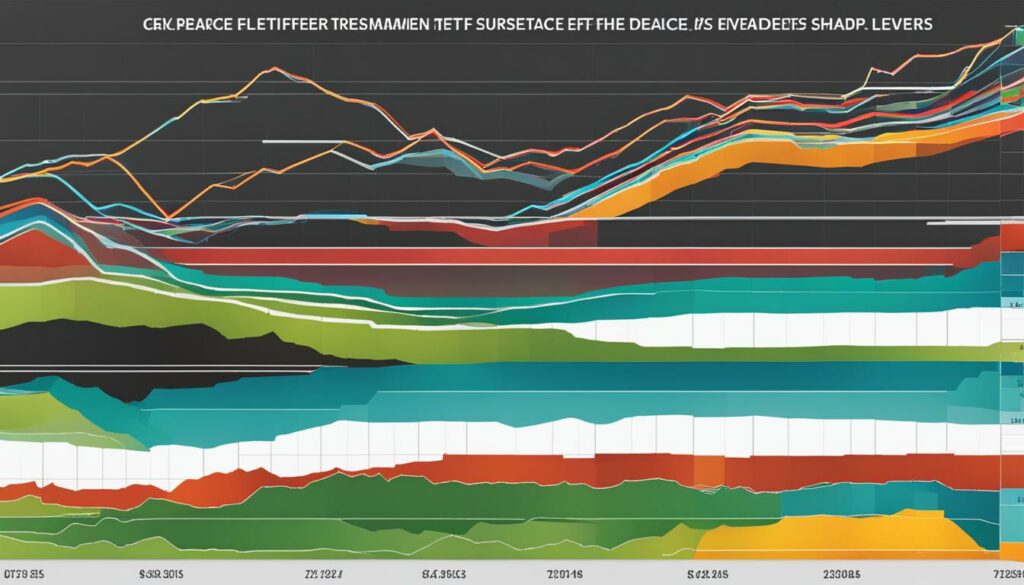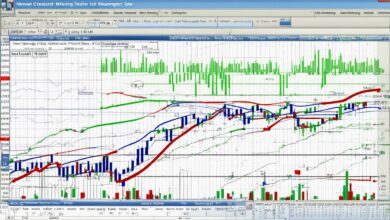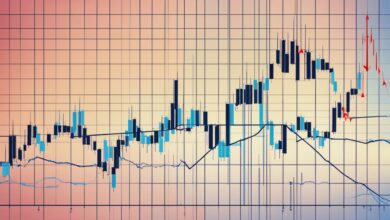ETF: What Is an Exchange-Traded Fund?


An exchange-traded fund (ETF) is a type of pooled investment security that operates like a mutual fund. ETFs track various assets such as indices, sectors, commodities, or specific investment strategies. They can be bought or sold on a stock exchange throughout the day, unlike mutual funds which are traded once a day. The first ETF was the SPDR S&P 500 ETF (SPY), which tracks the S&P 500 Index. ETFs offer low expense ratios, fewer broker commissions, and the ability to diversify holdings.
Key Takeaways:
- ETFs are pooled investment securities that track various assets.
- ETFs can be bought and sold on stock exchanges throughout the day.
- SPDR S&P 500 ETF was the first ETF.
- ETFs offer lower expense ratios and diversification.
- ETFs provide access to different asset classes.
Benefits of ETFs
ETFs offer numerous benefits to investors, making them a popular choice for those looking to diversify their portfolios and maximize returns. Here are some of the key advantages of investing in ETFs:
Diverse Asset Classes
One of the greatest advantages of ETFs is their ability to provide access to a wide range of asset classes. Whether you’re interested in investing in domestic or international stocks, bonds, or commodities, there is an ETF to suit your needs. This allows investors to create a diversified portfolio and reduce the risk associated with investing in a single security.
Lower Expense Ratios
Compared to actively managed mutual funds, ETFs typically have lower expense ratios. This means that investors will pay fewer fees to hold an ETF compared to a mutual fund with a similar investment objective. Lower expenses can lead to higher returns over the long term, making ETFs an attractive option for cost-conscious investors.
Trading Versatility
ETFs combine the trading versatility of individual securities with the diversification benefits of mutual funds. Unlike mutual funds, which are traded once a day after the market close, ETFs can be bought or sold on a stock exchange throughout the trading day. This flexibility allows investors to react to market conditions quickly and take advantage of intraday price movements.
Types of ETFs
ETFs come in various types, each with its own investment focus. Investors can choose from a wide range of ETFs to diversify their portfolios and align with their specific investment objectives. Let’s explore some of the common types of ETFs:
1. Stock ETFs
Stock ETFs track a particular stock market index, such as the S&P 500 or the Nasdaq. They provide investors with exposure to a broad range of stocks within a specific market or sector.
2. Commodity ETFs
Commodity ETFs invest in commodities like gold, silver, oil, or agricultural products. These ETFs offer an opportunity to gain exposure to commodity prices without physically owning the underlying assets.
3. Exchange-Traded Notes (ETNs)
ETNs are debt instruments issued by financial institutions. They track the performance of an index or a specific strategy. Unlike ETFs, ETNs don’t own the underlying assets but instead provide investors with returns linked to the index or strategy.
4. Bond ETFs
Bond ETFs invest in fixed-income securities like government bonds, corporate bonds, or municipal bonds. These ETFs provide income through interest payments and can help investors diversify their portfolios.
5. International ETFs
International ETFs provide exposure to stocks or bonds traded in international markets. Investors can gain access to specific countries or regions, allowing for global diversification.


6. Sector ETFs
Sector ETFs focus on specific industries or sectors, such as technology, healthcare, or energy. These ETFs allow investors to target their investments to industries they believe will outperform the broader market.
7. Leveraged ETFs
Leveraged ETFs aim to deliver returns that are a multiple of the underlying index’s performance. These ETFs use derivatives and other financial instruments to amplify returns, but they also come with increased risk and volatility.
8. Other ETFs
In addition to the mentioned types, there are other ETFs that provide exposure to unique assets or investment strategies. These include real estate ETFs, currency ETFs, and socially responsible ETFs, among others.
ETFs offer investors a wide range of choices to suit their investment preferences and goals. The table below summarizes some key features of different types of ETFs:
| Type of ETF | Investment Focus | Risk Level | Example |
|---|---|---|---|
| Stock ETFs | Stock market indices or sectors | Medium to high | S&P 500 ETF (SPY) |
| Commodity ETFs | Commodity prices | High | SPDR Gold Shares (GLD) |
| ETNs | Indexes or specific strategies | Medium to high | iPath S&P 500 VIX Short-Term Futures ETN (VXX) |
| Bond ETFs | Fixed-income securities | Low to medium | iShares Core U.S. Aggregate Bond ETF (AGG) |
| International ETFs | International stocks or bonds | Medium to high | Vanguard FTSE Emerging Markets ETF (VWO) |
| Sector ETFs | Specific industries or sectors | Medium to high | Technology Select Sector SPDR Fund (XLK) |
| Leveraged ETFs | Amplified returns | High | ProShares UltraPro QQQ (TQQQ) |
Investors should carefully consider their investment goals, risk tolerance, and research the specific ETFs before making investment decisions. The right combination of ETFs can help investors build a well-diversified and balanced portfolio.


Each type of ETF offers unique advantages and considerations. Investors should carefully analyze their investment goals, risk tolerance, and market conditions before selecting the most suitable ETFs for their portfolio. Consulting with a financial advisor can also provide valuable guidance in constructing a well-rounded and diversified ETF portfolio.
Three Essential Steps to Buy ETFs
- Research and analyze the objectives, performance history, and expense ratios of the ETFs you’re interested in.
- Select a platform or brokerage that offers access to a wide range of ETFs and suits your investment needs.
- Create an account, deposit funds, and execute your ETF trades based on your preferred trading strategy.
By following these steps and leveraging the diverse range of available platforms, you can effectively navigate the ETF market and capitalize on its potential for growth.
In order to make informed investment decisions, thorough analysis and research of the ETFs’ objectives, performance history, and expense ratios is necessary.
| Step | Action |
|---|---|
| 1 | Research and analyze the ETFs. |
| 2 | Select the appropriate platform or brokerage. |
| 3 | Create an account and execute trades based on your strategy. |
How ETFs Work
Exchange-Traded Funds (ETFs) are a popular investment vehicle that allows individuals to gain exposure to a diversified portfolio of assets. Understanding how ETFs work is essential for investors looking to harness the benefits of this type of investment.
ETFs are designed to track the value of underlying assets or indices, such as stocks, bonds, or commodities. However, unlike mutual funds, ETFs trade on stock exchanges throughout the day at market-determined prices that may differ from the actual value of the underlying assets. This provides investors with the opportunity to buy or sell ETF shares at any time during market hours.
Investors can buy shares of an ETF, which represents a portion of the underlying asset basket. The price of each ETF share is influenced by supply and demand dynamics in the market, similar to individual stocks. This means that the price of an ETF share can fluctuate throughout the trading day.
One key feature of ETFs is their ability to offer transparency to investors. ETFs disclose their holdings on a daily basis, allowing investors to easily monitor the price activity and the underlying assets within the ETF. This transparency provides investors with a greater understanding of their investment’s performance and helps them make informed decisions.
Authorized participants play a crucial role in the creation and redemption of ETF shares. These authorized participants, typically large financial institutions, can exchange cash or a portfolio of assets for ETF shares or vice versa. By creating or redeeming ETF shares, authorized participants help ensure that the market price of ETF shares aligns closely with the underlying assets’ value.


ETFs are an excellent tool for gaining exposure to a diverse range of asset classes and investment strategies. They offer investors the flexibility to buy and sell shares throughout the day at market-determined prices. With their transparency and cost efficiency, ETFs have become a popular choice among individual and institutional investors alike.
Advantages of ETFs
ETFs offer several benefits to investors, including diversification, flexibility, and cost efficiency. These advantages make ETFs an attractive option for individuals looking to build a well-rounded investment portfolio.
- Instant diversification across multiple assets or sectors
- Ability to buy and sell throughout the trading day
- Transparency in holdings and performance
- Lower expense ratios compared to actively managed mutual funds
- Flexible investment strategies for various goals and risk tolerances
Overall, understanding how ETFs work and the advantages they offer can empower investors to make informed decisions and effectively allocate their investment capital.
ETF Advantages
Investing in exchange-traded funds (ETFs) can offer numerous advantages to investors. Here are some of the key benefits that make ETFs an attractive choice for building a diversified portfolio.
Diversification Across Asset Classes, Industries, and Geographies
ETFs provide investors with a convenient way to diversify their portfolios across various asset classes, including stocks, bonds, commodities, and currencies. By investing in a single ETF, investors can gain exposure to a wide range of securities within a specific asset class or industry. For example, an investor interested in the technology sector can invest in a technology-focused ETF, which holds a diversified basket of technology companies.
Transparency and Tax Advantages
ETFs offer transparency, as they disclose their holdings on a daily basis. This allows investors to track the performance of the ETF and know exactly what assets they own. Additionally, ETFs generally have a favorable tax structure, which can help investors minimize their tax liabilities. Unlike mutual funds, ETFs are structured in a way that allows for in-kind transactions, which can minimize capital gains distributions.
Lower Expense Ratios
ETFs typically have lower expense ratios compared to actively managed mutual funds. This is because most ETFs are passively managed and aim to replicate the performance of an underlying index or asset class. The lower expenses associated with ETFs allow investors to keep more of their investment returns.
Liquidity and Trading Flexibility
ETFs can be bought and sold throughout the trading day on stock exchanges, providing investors with greater liquidity and trading flexibility. This allows investors to react quickly to market conditions and make timely investment decisions. Additionally, the ability to trade ETFs throughout the day ensures that investors can enter or exit positions at market-determined prices without having to wait for the end of the trading day.
Overall, ETFs offer a range of advantages, including diversification, transparency, tax efficiency, low expenses, and trading flexibility. These attributes make ETFs a popular choice among investors looking to build a well-rounded and efficient investment portfolio.


ETF Disadvantages
While investing in Exchange-Traded Funds (ETFs) can offer numerous benefits, it’s important to consider their potential disadvantages. Understanding these drawbacks can help investors make informed decisions and manage their investment portfolios effectively.
1. Increased Risk with Leveraged and Inverse ETFs:
Leveraged and inverse ETFs are designed to provide amplified returns corresponding to the performance of an underlying asset or index. However, their use involves higher levels of risk due to the potential for magnified losses. These types of ETFs are more suitable for experienced investors who understand the complex nature of their strategies and have a higher risk tolerance.
2. Higher Expense Ratios and Trading Costs:
Some ETFs may have higher expense ratios compared to others. These costs can impact investor returns, especially when held over the long term. Additionally, investors should consider trading costs associated with buying and selling ETFs, such as brokerage fees and bid/ask spreads. Conducting thorough research and comparing expense ratios and trading costs is essential before selecting an ETF.
3. Potential Tracking Errors:
ETFs aim to closely track the performance of their underlying assets or indices. However, tracking errors may occur, leading to a deviation between the ETF’s performance and the actual value of the assets it represents. These errors can arise from factors such as transaction costs, management fees, and timing discrepancies. Investors should monitor ETFs’ tracking errors to ensure their performance aligns with their investment objectives.
Despite these potential disadvantages, ETFs remain a popular investment choice due to their flexibility, diversification, and ease of trading. By understanding these drawbacks, investors can make informed decisions when incorporating ETFs into their investment portfolios.
| Advantages | Disadvantages |
|---|---|
| Access to diverse mix of asset classes | Increased risk with leveraged and inverse ETFs |
| Lower expense ratios compared to mutual funds | Higher expense ratios and trading costs |
| Trading versatility and liquidity | Potential tracking errors |
| Transparency and easy monitoring |


ETFs vs. Mutual Funds
Exchange-Traded Funds (ETFs) and mutual funds are popular investment options, each with its own unique characteristics. Understanding the differences between these two options can help investors make informed decisions about their investment strategies.
ETF Investing: ETFs are traded on exchanges throughout the day, just like individual stocks. Investors can buy and sell ETF shares at market-determined prices, allowing for flexibility and quick execution. This real-time trading feature makes ETFs ideal for investors who want to actively manage their portfolios and take advantage of short-term market movements.
ETF Funds: ETFs generally have lower expense ratios compared to mutual funds. This is because ETFs are passively managed, which means they track the performance of an underlying index and don’t require active fund management. Additionally, ETFs offer more transparency as their holdings are disclosed daily, allowing investors to see exactly what they own.
Mutual Funds: Mutual funds, on the other hand, are traded once a day at the net asset value (NAV) price. The NAV is calculated based on the value of the fund’s underlying assets at the end of the trading day. Mutual funds are often actively managed, meaning a fund manager makes investment decisions on behalf of investors. Mutual funds may be a better fit for investors who prefer a more hands-off approach to investing and are comfortable with long-term strategies.
Key Differences:
- Trading: ETFs are traded throughout the day, while mutual funds are traded once a day.
- Expense Ratios: ETFs generally have lower expense ratios compared to mutual funds.
- Transparency: ETFs offer more transparency as their holdings are disclosed daily.
Choosing the Right Option: When deciding between ETFs and mutual funds, investors should consider their investment goals, risk tolerance, and preferred level of involvement in managing their portfolios. Consulting with a financial advisor can also provide valuable guidance in selecting the most suitable investment option.
| ETFs | Mutual Funds | |
|---|---|---|
| Trading | Traded throughout the day on exchanges | Traded once a day at NAV price |
| Expense Ratios | Generally lower expense ratios | Expense ratios vary |
| Transparency | Holdings disclosed daily | Holdings disclosed periodically |
Note: The table above provides a summary of the key differences between ETFs and mutual funds. Investors should carefully review the prospectus and consider their own investment objectives before making any investment decisions.
ETF Costs
When considering investments in ETFs, it is essential for investors to be aware of the various costs associated with these funds. Understanding these costs can help investors evaluate their investment options and manage their ETF portfolio more effectively. Let’s take a closer look at the different elements that contribute to the overall costs of ETFs.
Brokerage Fees
One cost to consider when investing in ETFs is brokerage fees. These fees are charged by the broker for executing trades on your behalf. They can vary depending on the brokerage firm and the specific ETF you are trading. Some brokerages offer commission-free trading for certain ETFs, which can be a cost-saving option for investors.
Ongoing Management Fees
Another component of ETF costs is the ongoing management fees. These fees cover the expenses associated with managing and operating the ETF, such as administrative costs, portfolio management fees, and marketing expenses. Ongoing management fees are expressed as a percentage of the ETF’s assets under management (AUM) and are deducted from the fund’s net asset value (NAV).
Bid/Ask Spreads
Bid/ask spreads represent the difference between the highest price a buyer is willing to pay (bid) and the lowest price a seller is willing to accept (ask). When buying or selling ETF shares, investors will encounter bid/ask spreads, which can impact the cost of the trade. It is important to consider the bid/ask spreads when trading ETFs, as larger spreads can result in higher transaction costs.
Changes in Discounts or Premiums
ETFs can trade at a premium or discount to their net asset value (NAV). The premium or discount reflects the difference between the market price of the ETF and its NAV. Changes in discounts or premiums can impact the overall return and cost of owning an ETF. Investors should monitor the discounts or premiums of the ETFs in their portfolio to assess the potential impact on performance and costs.
Overall, understanding the costs associated with ETFs is crucial for investors to build and manage a successful ETF portfolio. By considering brokerage fees, ongoing management fees, bid/ask spreads, and changes in discounts or premiums, investors can make informed decisions and optimize their ETF investments.
ETF Investment Strategies
When it comes to investing in ETFs, there are various strategies that investors can employ to achieve their financial goals. Whether it’s generating income, speculating on market movements, aiming for price appreciation, or hedging against potential risks, ETFs provide the flexibility and diversification necessary for success. Let’s explore some popular ETF investment strategies:


1. Sector Rotation
With sector rotation, investors aim to capitalize on changing market trends by rotating their investments among different sectors. By identifying sectors that are expected to outperform, investors can use sector-based ETFs to gain targeted exposure and potentially maximize returns.
2. Swing Trading
Swing trading involves capturing short-term price movements in the market. ETFs can be useful instruments for swing trading strategies due to their intraday liquidity and ability to track specific sectors or indices. Traders can take advantage of price swings by buying and selling ETFs within a short timeframe.
3. Dollar-Cost Averaging
Dollar-cost averaging is a long-term investment strategy in which investors consistently invest a fixed amount of money in ETFs at regular intervals, regardless of market conditions. This approach allows investors to reduce the impact of market volatility on their investment returns and potentially benefit from market fluctuations over time.
“Dollar-cost averaging is a disciplined strategy that can help reduce the impact of market volatility on your investment portfolio. By investing a fixed amount at regular intervals, you can take advantage of market highs and lows.”
4. Portfolio Hedging
Investors can use ETFs to hedge against potential risks in their portfolios. By investing in inverse ETFs, which aim to profit from declining markets, or by having exposure to assets that tend to perform well in adverse market conditions, investors can help mitigate potential losses in their overall portfolio.
Remember to choose an ETF strategy that aligns with your investment goals, risk tolerance, and time horizon. Consulting with a qualified financial advisor can provide valuable insights and help you make informed investment decisions.
| ETF Investment Strategies | Description |
|---|---|
| Sector Rotation | Rotating investments among different sectors to capitalize on changing market trends. |
| Swing Trading | Capturing short-term price movements by buying and selling ETFs within a short timeframe. |
| Dollar-Cost Averaging | Consistently investing a fixed amount in ETFs at regular intervals, regardless of market conditions. |
| Portfolio Hedging | Using inverse ETFs or assets that perform well in declining markets to mitigate potential portfolio losses. |
Choosing the Right ETFs
When it comes to investing in ETFs, it’s crucial for investors to carefully select the right options that align with their investment objectives, time frame, and risk tolerance. Conducting thorough research is key in making informed decisions.
Investors should start by examining the underlying assets of the ETFs they are considering. Understanding what the ETF holds will provide insights into its potential returns and risks. This analysis should also include evaluating the expense ratios of the ETFs to gauge their cost-effectiveness.
Liquidity and trading volume are equally important factors to consider. Opting for ETFs with sufficient liquidity ensures ease of buying and selling, even during periods of market volatility. Adequate trading volume can prevent slippage and ensure that investors can execute their trades at desired prices.




